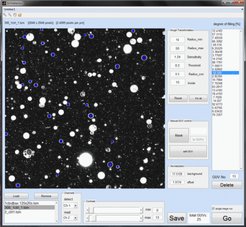Software
GUV Software
PASS Software
Software for Automatic Analysis of Giant Unilamellar Vesicles (GUV)

We developed a software for the automated detection and analysis of giant unilamellar vesicles (GUVs) on fluorescent microscopy images. The detection algorithm is based on the Circular Hough Transformation, a powerful method to detect circles. The software is suited to characterize in detail protein binding to membranes and mechanisms of membrane permeabilization at the single vesicle level. Concretely, it can be used to quantify the degree of permeabilization, the filling kinetics, protein binding to the membrane as well as the pore size and stability of the permeabilized state of individual vesicles using multiframe images or movies as input.
For more information, please see Hermann et al., Bioinformatics (2014).
The software is implemented in Matlab and requires at least Matlab R2012b including Image Processing Toolbox and Signal Processing Toolbox. Additionally, a standalone version for Windows7 64 bit is available, designed to run the program without Matlab (download here plus the readme.txt). Before using the standalone tool, make sure you have the MCRInstaller R2013b for Windows7 64 bit installed (otherwise download it here).
For further information, please refer to the instruction manual. If you have any questions, please contact me via b.kisters[at]uni-koeln.de.
Programmed Analysis of Super-Resolved Structures (PASS)
Super resolution microscopy is an important tool for observing the structural organization of nano-scopic cellular machineries in their native environments and under physiological conditions. Powerful advances in optical engineering and probe chemistry has opened the door for accessing the architecture of such machinery at staggering spatiotemporal resolutions. Despite recent efforts to improve the speed, resolution and quality of acquisitions, the classification and analysis of super resolved structures has been largely limited to inaccurate and time-consuming human implementation. Non-automated classi?cation and analysis of super resolved structures has, thus far, hindered biologically-relevant statistical inference across scales and under different conditions from being realized. Observing the need for an automated tool solving this problem, we developed PASS, Programmed Analysis of Super-resolved Structures, as a rapid and robust computational suite for classifying, analyzing and clustering super resolved structures. Using this tool, researchers can classify structures present in super-resolved images, analyze their geometrical dimensions, statistically compare the effect of different sample preparation routes on the size of the individual structures and study the correlation between the growth dynamics of one protein complex on many others. This guide describes how to use PASS and the output to expect from it. The user should follow the steps described in this guide in the order they were written to avoid failure. PASS is image-based. This implies that it is suited for processing images obtained using coordinate-targeted (STED and SSIM) and localization-based (STORM, PALM, DNA-Paint) super resolution microscopy techniques.
For further information, please refer to the instruction manual.
